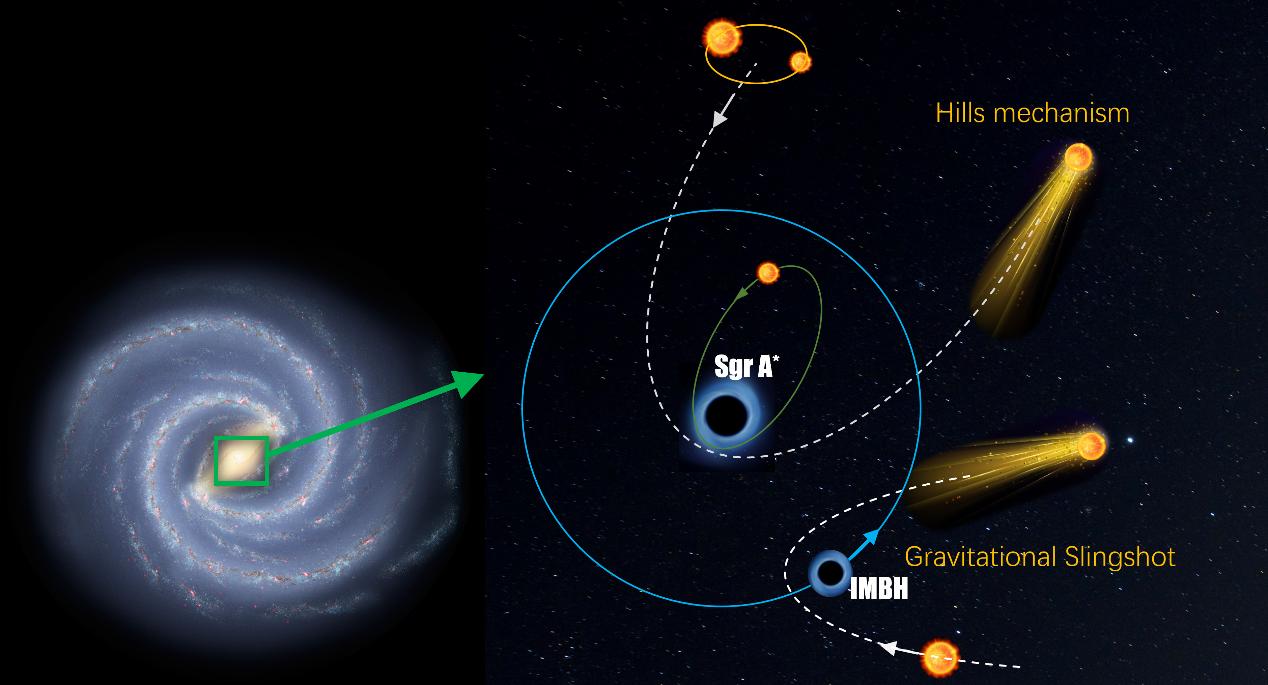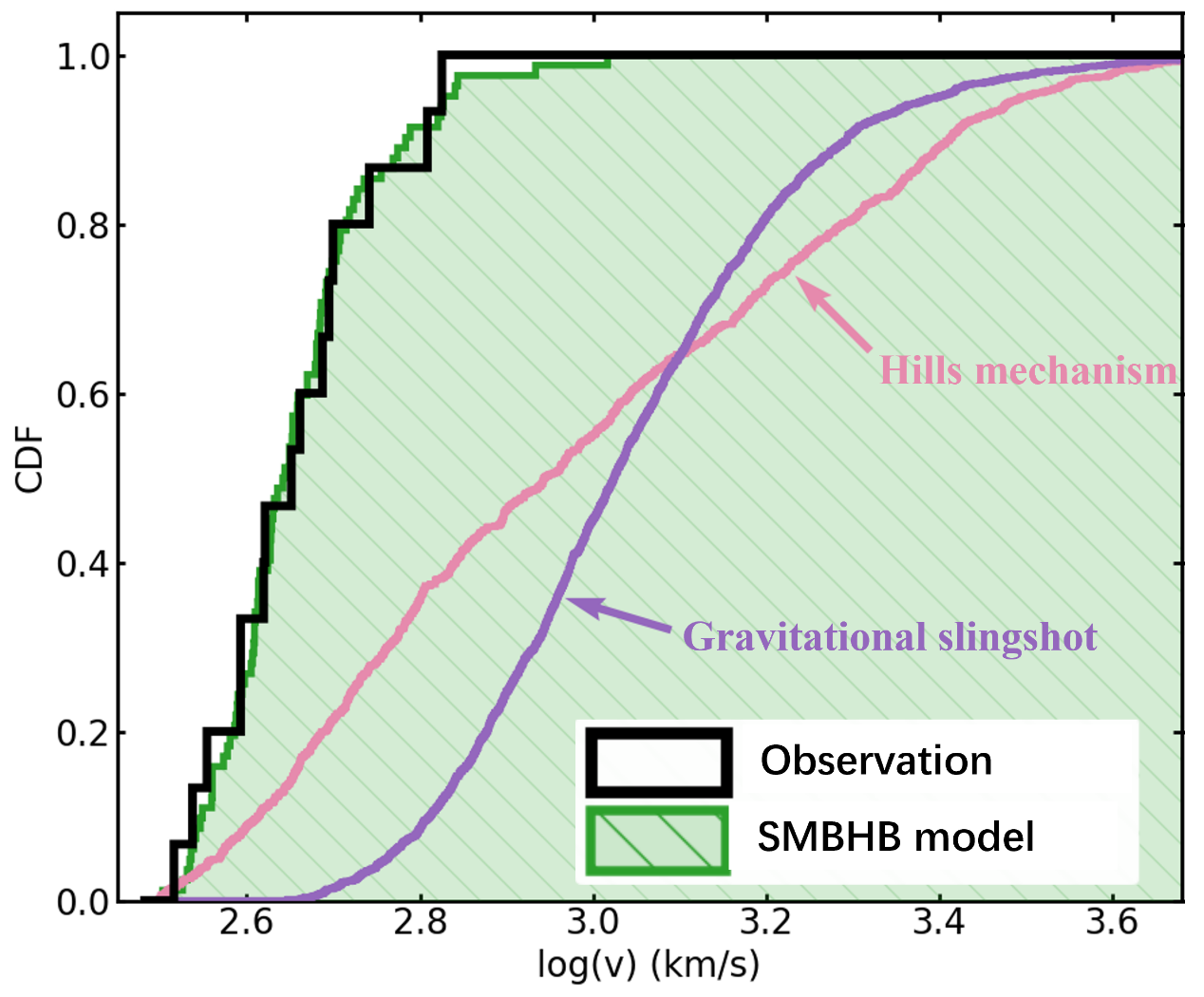A research team led by Professor Liu Fukun from the Department of Astronomy at the School of Physics of Peking University and the Kavli Institute for Astronomy and Astrophysics recently discovered that the supermassive black hole at the center of our galaxy, Sgr A*, merged with an intermediate black hole about 10 million years ago. When stars get too close to a supermassive black hole, they can be thrown out at high speeds and become a hypervelocity star. By analyzing the velocity distribution of these hypervelocity stars in the Milky Way halo, the team found that between 50 and 250 million years ago, an intermediate-mass black hole of approximately 15,000 times the mass of the Sun existed near the supermassive black hole Sgr A* at the Galactic center.
The Milky Way has swallowed up multiple smaller dwarf galaxies throughout its history. Scientists have long speculated that these dwarf galaxies may harbor intermediate-mass black holes at their centers, some of which could form binary black hole systems with the supermassive black hole Sgr A* at the Milky Way's center. The two black holes would gradually approach each other through gravitational wave radiation and eventually merge.
Although the past merger events of the binary black holes at the Milky Way's center cannot be directly observed, they can be traced by studying the hypervelocity stars. Hypervelocity stars are the stars ejected from the Galactic center at extremely high speeds, reaching hundreds of kilometers per second. To date, scientists have identified about 20 such stars, whose orbits encode information about the past environment of the Galactic center. Scientists believe that these hypervelocity stars can be produced in two mechanisms, either through the tidal separation of a binary star by a supermassive black hole followed by the ejection of one star (Hills mechanism), or through the interaction of a single star with a binary supermassive black hole (gravitational slingshot effect). However, both mechanisms predict the production of a large number fraction of hypervelocity stars with extreme velocities (greater than about 700 kilometers per second), which contradicts the observations.

Figure 1: A schematic diagram (right) for the two mechanisms of producing hypervelocity stars at the center of the Milky Way (left). One mechanism involves a binary star being separated by the tidal force of the supermassive black hole Sgr A* followed by the ejection of one star at an extremely high velocity (Hills mechanism). The other mechanism involves a single star interacting with an intermediate-mass black hole (IMBH) orbiting Sgr A*, gaining high velocity through the gravitational slingshot effect. (Image of the Milky Way: NASA/JPL-Caltech.)
Professor Liu Fukun's research team found that a binary black hole system that merged recently (10 million years ago) can naturally explain the rarity of such extreme hypervelocity stars. The model suggests that when a binary black hole system exists, single or binary stars are more likely to interact with the less massive black hole, resulting in relatively low ejection velocities. Only after the merge of the binary black hole can binary stars interact frequently with the more massive central black hole, achieving extremely high ejection velocities.

Figure 2: The cumulative velocity distribution histogram of hypervelocity stars. The black histogram shows the observational data from the MMT project, and the green histogram shows the result from the supermassive black hole binary model of this study, both exhibiting an upper velocity limit at 700 km/s. In contrast, the velocity distributions predicted by the other two models (purple line for the Hills mechanism; pink line for the gravitational slingshot effect) clearly deviate from the observations.
By analyzing the velocity distribution of hypervelocity stars, the research team infers that an intermediate-mass black hole of approximately 15,000 solar mass once existed at the Milky Way's center between 50 and 250 million years ago, which eventually merged with Sgr A* around 10 million years ago. Based on the mass, evolutionary history, and orbital properties of this intermediate-mass black hole, the team speculates that it is very likely from a dwarf galaxy known as the "Sausage" galaxy, which was consumed by the Milky Way around 10 billion years ago. This model not only reproduces the velocity and distance distributions of the hypervelocity stars but also provides a compelling explanation for the orbital size and age distribution of the S-star cluster at the Milky Way's center, as well as the proper motion of the supermassive black hole Sgr A*.
This discovery not only explains the velocity distribution of the hypervelocity stars but also offers new insights into the formation and evolution of the supermassive black hole at the Milky Way's center. In the future, with the deployment of more advanced observational instruments, such as Large Synoptic Survey Telescope, scientists hope to discover more hypervelocity stars, further deepening our understanding of the history of the Galactic center.
This discovery was published in the 2025 March 26 edition of The Astrophysical Journal Letters. Cao Chunyang, a Ph.D. student at the Department of Astronomy of Peking University, is the first author of the paper, with Liu Fukun as the corresponding author. Li Shuo from the National Astronomical Observatories of the Chinese Academy of Sciences, Chen Xian from the Department of Astronomy of Peking University, and Wang Ke from the Kavli Institute for Astronomy and Astrophysics are co-authors. The research is supported by the National Natural Science Foundation of China's Innovative Research Group.
Full article link:
https://iopscience.iop.org/article/10.3847/2041-8213/adbbf2
PKU News:
https://news.pku.edu.cn/jxky/34f35dfe7bd84797b77b43f8e1ead837.htm